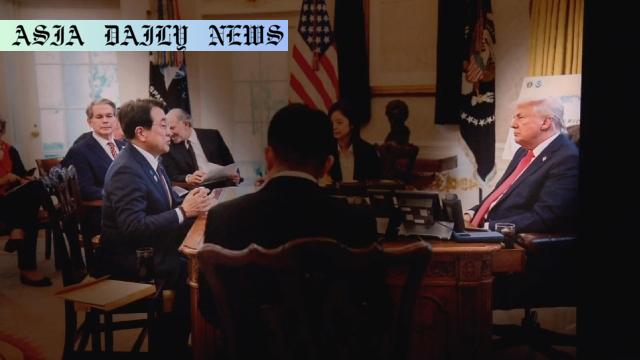Tariff Negotiations: The US pressed Japan to reform safety standards for cars and to expand import opportunities for farm goods.
The US raised multiple trade demands during negotiations with Japan.
Key focus areas included automobiles, rice, meat, and seafood.
Japan’s negotiator aimed to prioritize US requests for specific trade items.
US pushed for a review of Japanese car safety standards as a non-tariff barrier.
Trump highlighted the trade deficit with Japan, aiming to bring it to zero.
Japan currently imports significant volumes of US agricultural goods and cars.
Concerns about the cost burden of the US-Japan security alliance were raised.

Introduction to Tariff Negotiations Between US and Japan
The United States and Japan recently convened for a significant round of tariff negotiations, addressing key trade barriers and economic concerns. The discussions, spanning across multiple sectors, reflect the ambition of both sides to redefine trade relations amid existing global economic dynamics. These talks were initiated with the US bringing forward a detailed list of demands targeting areas such as automobiles, agricultural produce, and security cost-sharing, highlighting long-standing trade imbalances and barriers between the two nations.
US Targets Japanese Auto Industry
A major contention point during the discussions revolved around the Japanese automobile market. The US highlighted Japan’s safety standards for vehicles as a non-tariff barrier. Officials claimed these regulations effectively restricted the entry of American cars into the Japanese market. While President Donald Trump alleged an insufficient presence of American automobiles on Japanese roads, industry data painted a slightly different picture, with over 10,000 American cars being sold in Japan during fiscal 2024, excluding Tesla models. Nevertheless, the US negotiators pressed Japan to ease restrictions to pave the way for higher penetration of American vehicles, alleging that the current system skewed the trade balance significantly.
Focus on Agricultural Products
Another prominent theme in the discussions was the trade of agricultural goods. The US listed several key items, including rice, meat, seafood, and potatoes, as high-priority trade opportunities. Japan, a major importer of US agricultural produce, recorded $14.9 billion worth of imports in 2022, which constituted 7.7% of the US’s global agricultural exports. Despite this substantial volume, the US delegation pushed for increased access, emphasizing how crucial these commodities are for balancing the trade deficit. President Trump further complained that Japan does not purchase enough from US farmers, reiterating the need for Japan to widen its agricultural market opportunities significantly.
Addressing the Trade Deficit
The trade deficit between the United States and Japan loomed prominently in the negotiations. President Trump conveyed the US’s dissatisfaction with the existing trade gap and set a bold target of reducing it to zero. While Japan maintains its economic resilience as a top global importer of several US goods, Trump argued that its import regulations still deterred considerable opportunities for American businesses. This demand for parity sparked a compelling debate, with American officials emphasizing lower barriers and greater reciprocity in trade engagements moving forward.
Security Alliance and Financial Responsibilities
In addition to trade-specific matters, the negotiations also touched upon the expenses associated with the US-Japan security alliance. President Trump raised concerns that Japan was not contributing adequately toward these costs. Tokyo and Washington have historically benefited from a longstanding partnership addressing regional security threats, but the financial burden of these arrangements has often remained a contentious point. The US delegation expressed the intent to recalibrate the financial responsibilities, ensuring a more equitable cost-sharing mechanism.
Looking Forward: Strategic Opportunities
While the talks showcased notable disagreements, they also emphasized the shared economic interests between the United States and Japan. With both nations recognizing the importance of their trade relationship, the next rounds of negotiations are likely to delve deeper into structural reforms and specific trade frameworks. Striking a balance between mutual demands and national interests will be critical in achieving a comprehensive agreement that benefits both economies.



Commentary
Analyzing the Dynamics of US-Japan Trade Talks
The recent tariff negotiations between the United States and Japan represent a pivotal moment in their bilateral relationship. The scope and focus of these discussions underline the significant trade disparities and structural barriers that have persisted over years. From automobiles to agriculture, the US’s demands emphasize its ambition to level the playing field, while Japan’s responses highlight its cautious, strategic approach to protect domestic interests. These dynamics underscore the intricate balancing act required in forging equitable trade agreements between major global economies.
Key Issues in Focus
It was particularly striking how the discussions spotlighted Japan’s safety standards in the automotive sector, framing them as a major non-tariff barrier. While these regulations aim to ensure consumer safety, the perception from the US is that they disproportionately disadvantage American cars. Balancing consumer safety with trade facilitation is a critical challenge, and resolving this issue could redefine trade in the automotive sector.
Broader Implications for Global Trade
The emphasis on agriculture and security cost-sharing adds further complexity to these negotiations. Japan’s substantial imports of American agricultural products demonstrate that the trade relationship already benefits both sides to a degree. However, elevating this exchange to new heights will require compromises, diplomacy, and mutual investments. Additionally, the financial aspects of the US-Japan security alliance pose broader questions about how nations share responsibilities in a world increasingly shaped by economic and political interdependencies.
Conclusion
In conclusion, these trade talks highlight both challenges and opportunities in the ongoing US-Japan relationship. By addressing existing barriers with transparency and forging pragmatic compromises, both nations have the potential to strengthen economic ties, promote equitable trade practices, and define a new era in their partnership. This chapter in global trade history reinforces the importance of collaboration in resolving disputes while striving for economic progress.